Reflection on GEM Experience
VerifiedAdded on 2023/03/31
|8
|1650
|372
AI Summary
This reflection discusses the experience of working on a marketing project for GEM, a non-profit organization supporting disabled children. It explores team dynamics, role assignment, and group norms.
Contribute Materials
Your contribution can guide someone’s learning journey. Share your
documents today.
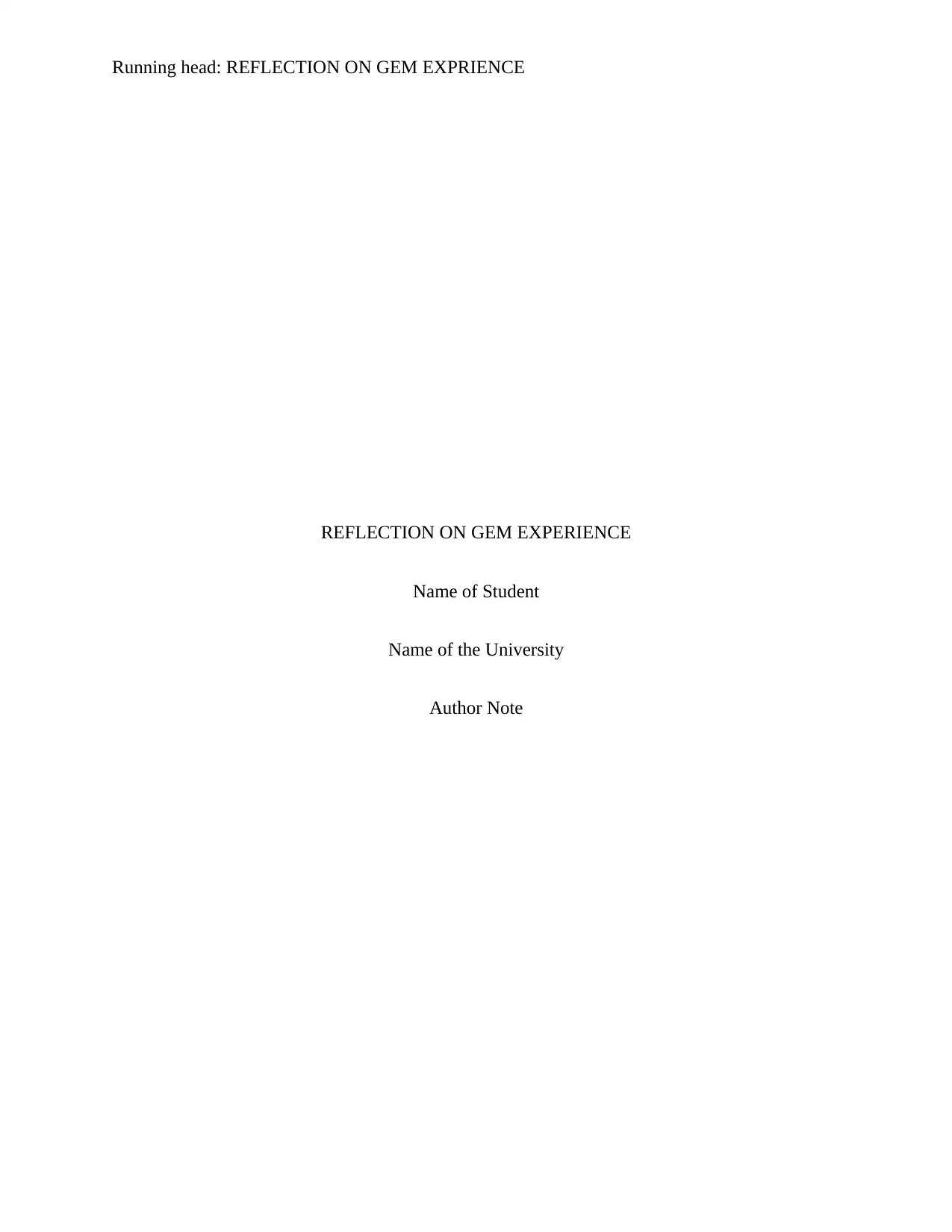
Running head: REFLECTION ON GEM EXPRIENCE
REFLECTION ON GEM EXPERIENCE
Name of Student
Name of the University
Author Note
REFLECTION ON GEM EXPERIENCE
Name of Student
Name of the University
Author Note
Secure Best Marks with AI Grader
Need help grading? Try our AI Grader for instant feedback on your assignments.
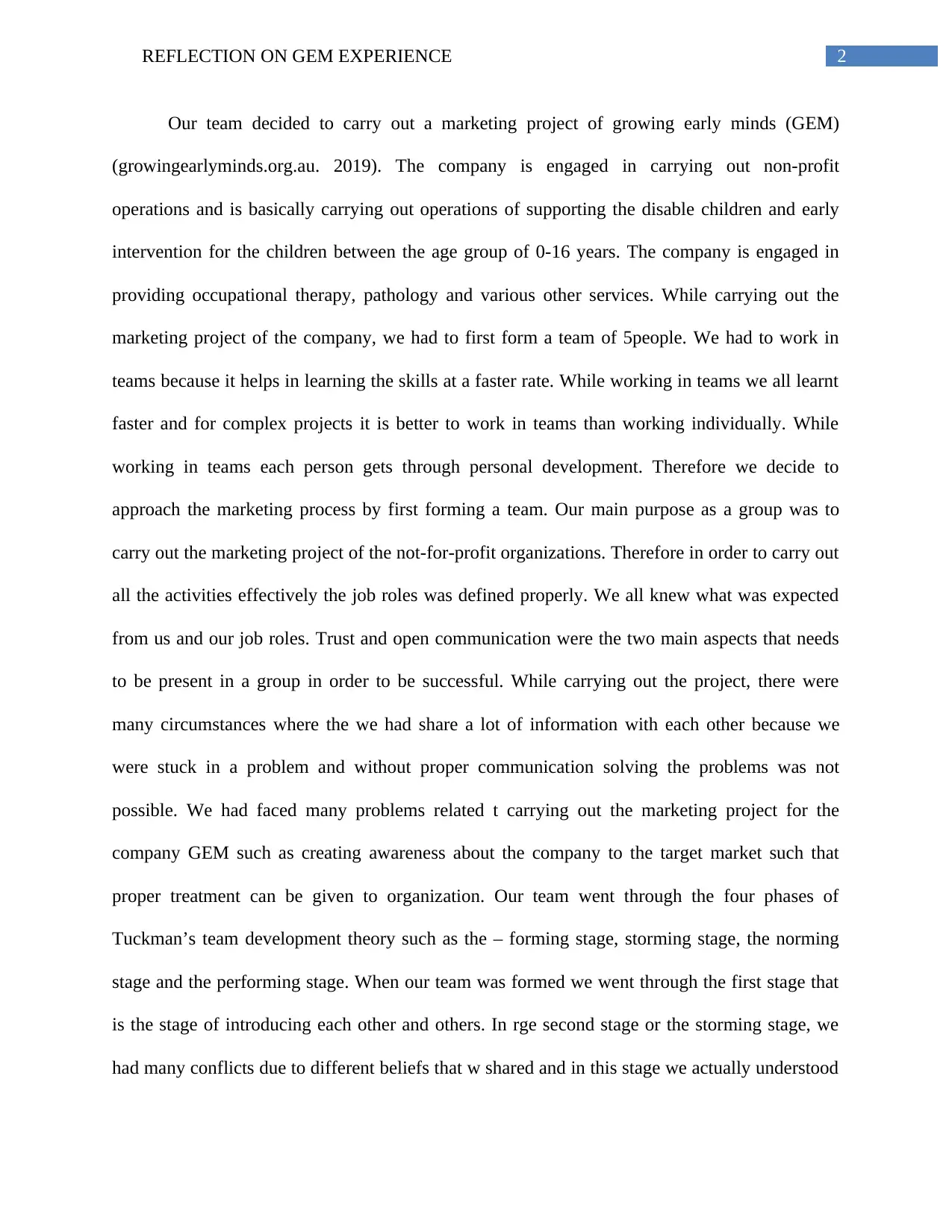
2REFLECTION ON GEM EXPERIENCE
Our team decided to carry out a marketing project of growing early minds (GEM)
(growingearlyminds.org.au. 2019). The company is engaged in carrying out non-profit
operations and is basically carrying out operations of supporting the disable children and early
intervention for the children between the age group of 0-16 years. The company is engaged in
providing occupational therapy, pathology and various other services. While carrying out the
marketing project of the company, we had to first form a team of 5people. We had to work in
teams because it helps in learning the skills at a faster rate. While working in teams we all learnt
faster and for complex projects it is better to work in teams than working individually. While
working in teams each person gets through personal development. Therefore we decide to
approach the marketing process by first forming a team. Our main purpose as a group was to
carry out the marketing project of the not-for-profit organizations. Therefore in order to carry out
all the activities effectively the job roles was defined properly. We all knew what was expected
from us and our job roles. Trust and open communication were the two main aspects that needs
to be present in a group in order to be successful. While carrying out the project, there were
many circumstances where the we had share a lot of information with each other because we
were stuck in a problem and without proper communication solving the problems was not
possible. We had faced many problems related t carrying out the marketing project for the
company GEM such as creating awareness about the company to the target market such that
proper treatment can be given to organization. Our team went through the four phases of
Tuckman’s team development theory such as the – forming stage, storming stage, the norming
stage and the performing stage. When our team was formed we went through the first stage that
is the stage of introducing each other and others. In rge second stage or the storming stage, we
had many conflicts due to different beliefs that w shared and in this stage we actually understood
Our team decided to carry out a marketing project of growing early minds (GEM)
(growingearlyminds.org.au. 2019). The company is engaged in carrying out non-profit
operations and is basically carrying out operations of supporting the disable children and early
intervention for the children between the age group of 0-16 years. The company is engaged in
providing occupational therapy, pathology and various other services. While carrying out the
marketing project of the company, we had to first form a team of 5people. We had to work in
teams because it helps in learning the skills at a faster rate. While working in teams we all learnt
faster and for complex projects it is better to work in teams than working individually. While
working in teams each person gets through personal development. Therefore we decide to
approach the marketing process by first forming a team. Our main purpose as a group was to
carry out the marketing project of the not-for-profit organizations. Therefore in order to carry out
all the activities effectively the job roles was defined properly. We all knew what was expected
from us and our job roles. Trust and open communication were the two main aspects that needs
to be present in a group in order to be successful. While carrying out the project, there were
many circumstances where the we had share a lot of information with each other because we
were stuck in a problem and without proper communication solving the problems was not
possible. We had faced many problems related t carrying out the marketing project for the
company GEM such as creating awareness about the company to the target market such that
proper treatment can be given to organization. Our team went through the four phases of
Tuckman’s team development theory such as the – forming stage, storming stage, the norming
stage and the performing stage. When our team was formed we went through the first stage that
is the stage of introducing each other and others. In rge second stage or the storming stage, we
had many conflicts due to different beliefs that w shared and in this stage we actually understood
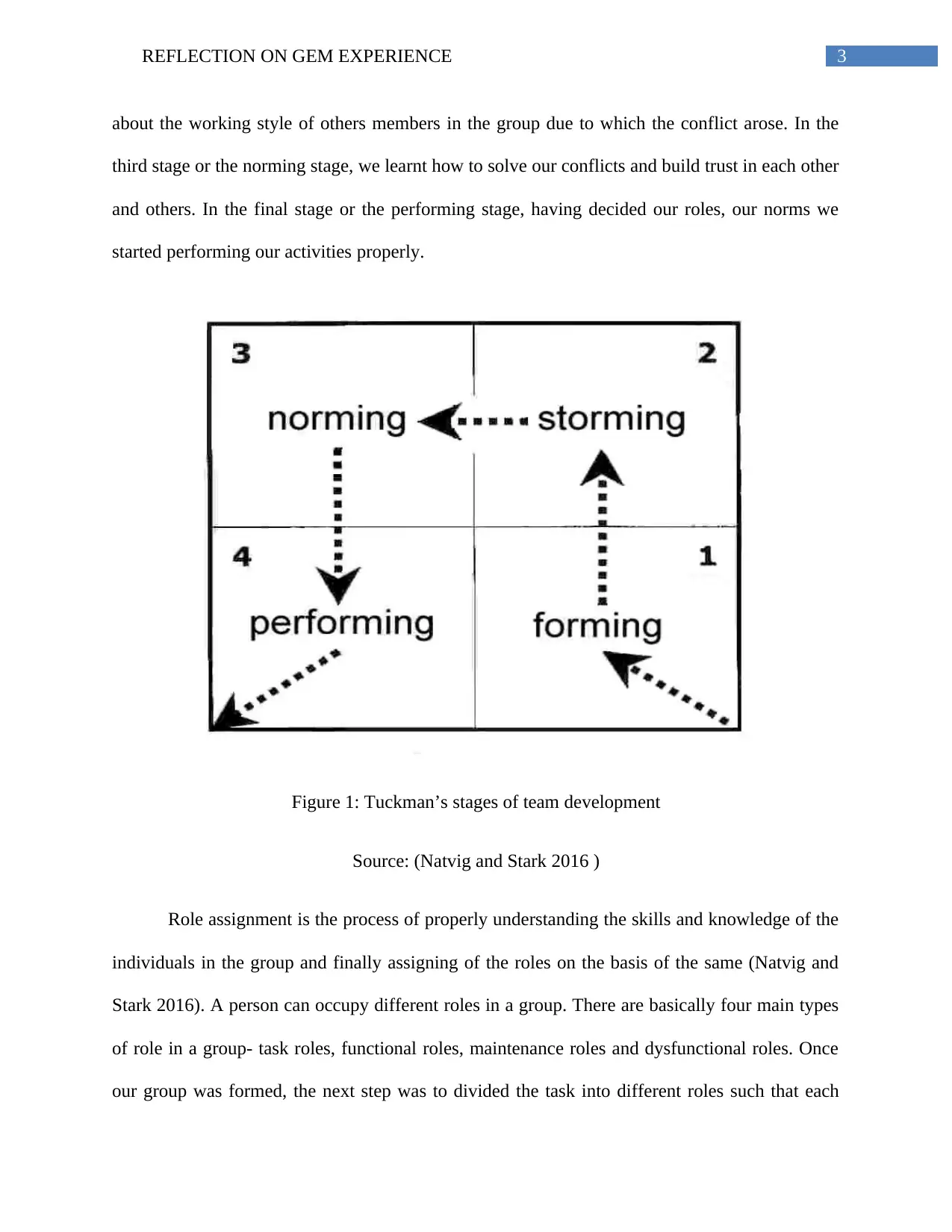
3REFLECTION ON GEM EXPERIENCE
about the working style of others members in the group due to which the conflict arose. In the
third stage or the norming stage, we learnt how to solve our conflicts and build trust in each other
and others. In the final stage or the performing stage, having decided our roles, our norms we
started performing our activities properly.
Figure 1: Tuckman’s stages of team development
Source: (Natvig and Stark 2016 )
Role assignment is the process of properly understanding the skills and knowledge of the
individuals in the group and finally assigning of the roles on the basis of the same (Natvig and
Stark 2016). A person can occupy different roles in a group. There are basically four main types
of role in a group- task roles, functional roles, maintenance roles and dysfunctional roles. Once
our group was formed, the next step was to divided the task into different roles such that each
about the working style of others members in the group due to which the conflict arose. In the
third stage or the norming stage, we learnt how to solve our conflicts and build trust in each other
and others. In the final stage or the performing stage, having decided our roles, our norms we
started performing our activities properly.
Figure 1: Tuckman’s stages of team development
Source: (Natvig and Stark 2016 )
Role assignment is the process of properly understanding the skills and knowledge of the
individuals in the group and finally assigning of the roles on the basis of the same (Natvig and
Stark 2016). A person can occupy different roles in a group. There are basically four main types
of role in a group- task roles, functional roles, maintenance roles and dysfunctional roles. Once
our group was formed, the next step was to divided the task into different roles such that each
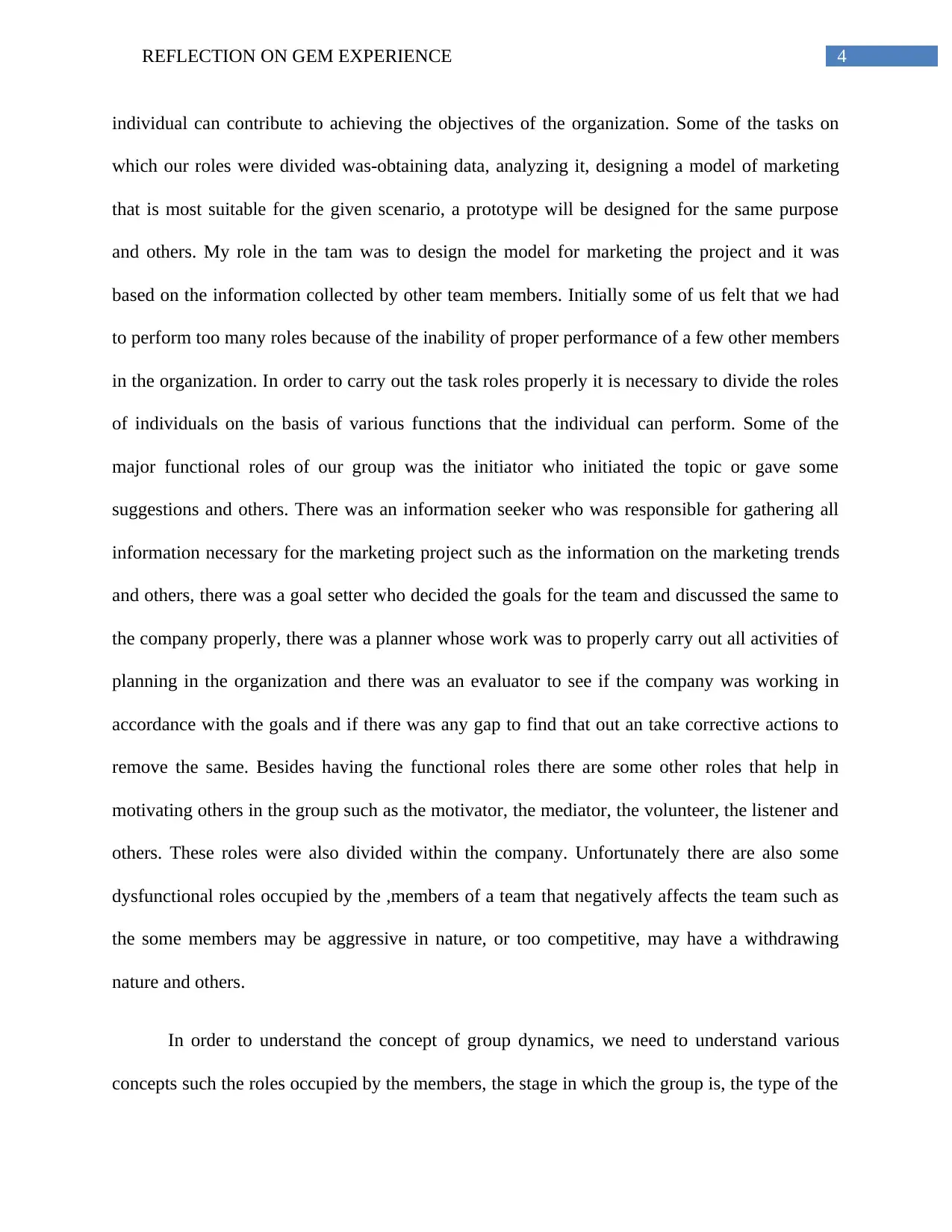
4REFLECTION ON GEM EXPERIENCE
individual can contribute to achieving the objectives of the organization. Some of the tasks on
which our roles were divided was-obtaining data, analyzing it, designing a model of marketing
that is most suitable for the given scenario, a prototype will be designed for the same purpose
and others. My role in the tam was to design the model for marketing the project and it was
based on the information collected by other team members. Initially some of us felt that we had
to perform too many roles because of the inability of proper performance of a few other members
in the organization. In order to carry out the task roles properly it is necessary to divide the roles
of individuals on the basis of various functions that the individual can perform. Some of the
major functional roles of our group was the initiator who initiated the topic or gave some
suggestions and others. There was an information seeker who was responsible for gathering all
information necessary for the marketing project such as the information on the marketing trends
and others, there was a goal setter who decided the goals for the team and discussed the same to
the company properly, there was a planner whose work was to properly carry out all activities of
planning in the organization and there was an evaluator to see if the company was working in
accordance with the goals and if there was any gap to find that out an take corrective actions to
remove the same. Besides having the functional roles there are some other roles that help in
motivating others in the group such as the motivator, the mediator, the volunteer, the listener and
others. These roles were also divided within the company. Unfortunately there are also some
dysfunctional roles occupied by the ,members of a team that negatively affects the team such as
the some members may be aggressive in nature, or too competitive, may have a withdrawing
nature and others.
In order to understand the concept of group dynamics, we need to understand various
concepts such the roles occupied by the members, the stage in which the group is, the type of the
individual can contribute to achieving the objectives of the organization. Some of the tasks on
which our roles were divided was-obtaining data, analyzing it, designing a model of marketing
that is most suitable for the given scenario, a prototype will be designed for the same purpose
and others. My role in the tam was to design the model for marketing the project and it was
based on the information collected by other team members. Initially some of us felt that we had
to perform too many roles because of the inability of proper performance of a few other members
in the organization. In order to carry out the task roles properly it is necessary to divide the roles
of individuals on the basis of various functions that the individual can perform. Some of the
major functional roles of our group was the initiator who initiated the topic or gave some
suggestions and others. There was an information seeker who was responsible for gathering all
information necessary for the marketing project such as the information on the marketing trends
and others, there was a goal setter who decided the goals for the team and discussed the same to
the company properly, there was a planner whose work was to properly carry out all activities of
planning in the organization and there was an evaluator to see if the company was working in
accordance with the goals and if there was any gap to find that out an take corrective actions to
remove the same. Besides having the functional roles there are some other roles that help in
motivating others in the group such as the motivator, the mediator, the volunteer, the listener and
others. These roles were also divided within the company. Unfortunately there are also some
dysfunctional roles occupied by the ,members of a team that negatively affects the team such as
the some members may be aggressive in nature, or too competitive, may have a withdrawing
nature and others.
In order to understand the concept of group dynamics, we need to understand various
concepts such the roles occupied by the members, the stage in which the group is, the type of the
Paraphrase This Document
Need a fresh take? Get an instant paraphrase of this document with our AI Paraphraser
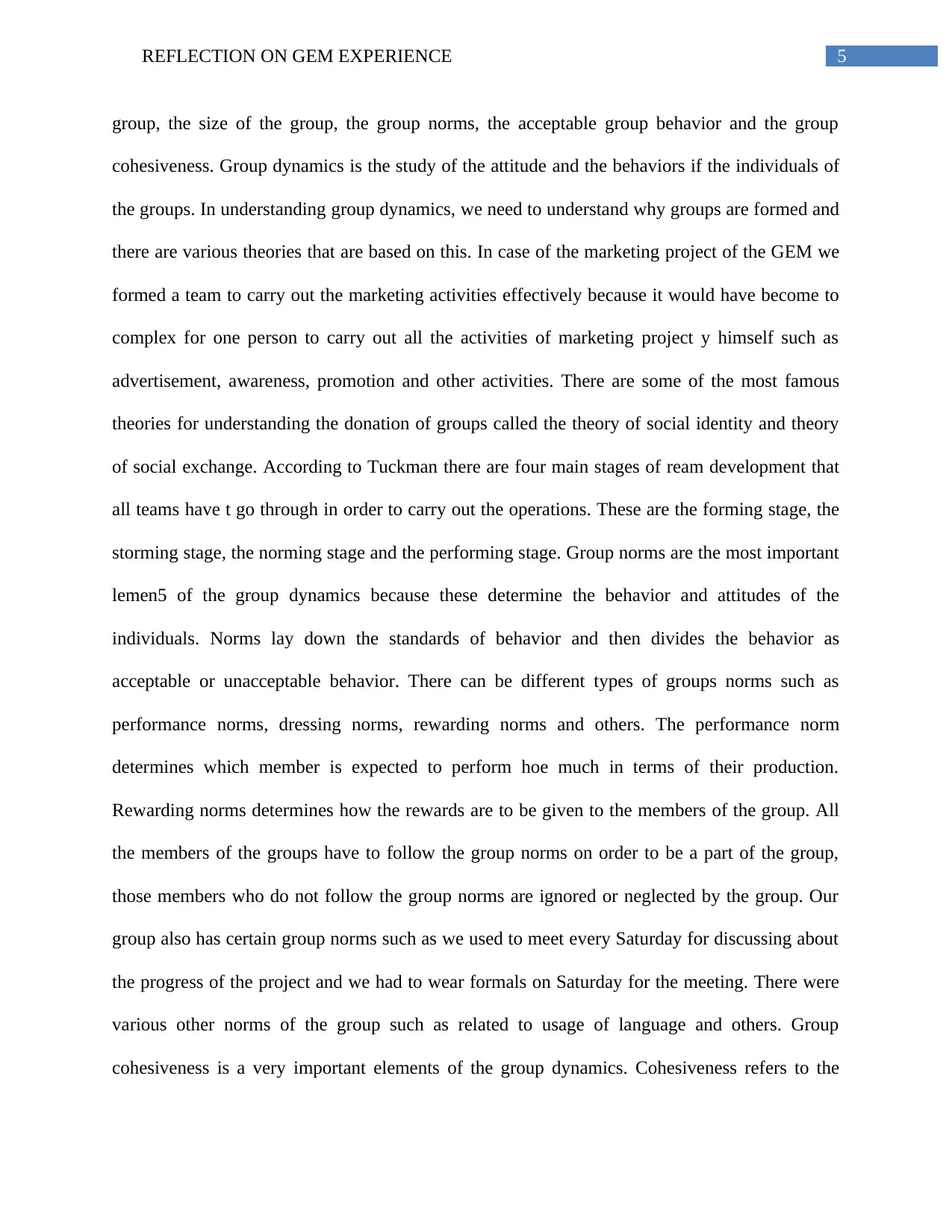
5REFLECTION ON GEM EXPERIENCE
group, the size of the group, the group norms, the acceptable group behavior and the group
cohesiveness. Group dynamics is the study of the attitude and the behaviors if the individuals of
the groups. In understanding group dynamics, we need to understand why groups are formed and
there are various theories that are based on this. In case of the marketing project of the GEM we
formed a team to carry out the marketing activities effectively because it would have become to
complex for one person to carry out all the activities of marketing project y himself such as
advertisement, awareness, promotion and other activities. There are some of the most famous
theories for understanding the donation of groups called the theory of social identity and theory
of social exchange. According to Tuckman there are four main stages of ream development that
all teams have t go through in order to carry out the operations. These are the forming stage, the
storming stage, the norming stage and the performing stage. Group norms are the most important
lemen5 of the group dynamics because these determine the behavior and attitudes of the
individuals. Norms lay down the standards of behavior and then divides the behavior as
acceptable or unacceptable behavior. There can be different types of groups norms such as
performance norms, dressing norms, rewarding norms and others. The performance norm
determines which member is expected to perform hoe much in terms of their production.
Rewarding norms determines how the rewards are to be given to the members of the group. All
the members of the groups have to follow the group norms on order to be a part of the group,
those members who do not follow the group norms are ignored or neglected by the group. Our
group also has certain group norms such as we used to meet every Saturday for discussing about
the progress of the project and we had to wear formals on Saturday for the meeting. There were
various other norms of the group such as related to usage of language and others. Group
cohesiveness is a very important elements of the group dynamics. Cohesiveness refers to the
group, the size of the group, the group norms, the acceptable group behavior and the group
cohesiveness. Group dynamics is the study of the attitude and the behaviors if the individuals of
the groups. In understanding group dynamics, we need to understand why groups are formed and
there are various theories that are based on this. In case of the marketing project of the GEM we
formed a team to carry out the marketing activities effectively because it would have become to
complex for one person to carry out all the activities of marketing project y himself such as
advertisement, awareness, promotion and other activities. There are some of the most famous
theories for understanding the donation of groups called the theory of social identity and theory
of social exchange. According to Tuckman there are four main stages of ream development that
all teams have t go through in order to carry out the operations. These are the forming stage, the
storming stage, the norming stage and the performing stage. Group norms are the most important
lemen5 of the group dynamics because these determine the behavior and attitudes of the
individuals. Norms lay down the standards of behavior and then divides the behavior as
acceptable or unacceptable behavior. There can be different types of groups norms such as
performance norms, dressing norms, rewarding norms and others. The performance norm
determines which member is expected to perform hoe much in terms of their production.
Rewarding norms determines how the rewards are to be given to the members of the group. All
the members of the groups have to follow the group norms on order to be a part of the group,
those members who do not follow the group norms are ignored or neglected by the group. Our
group also has certain group norms such as we used to meet every Saturday for discussing about
the progress of the project and we had to wear formals on Saturday for the meeting. There were
various other norms of the group such as related to usage of language and others. Group
cohesiveness is a very important elements of the group dynamics. Cohesiveness refers to the
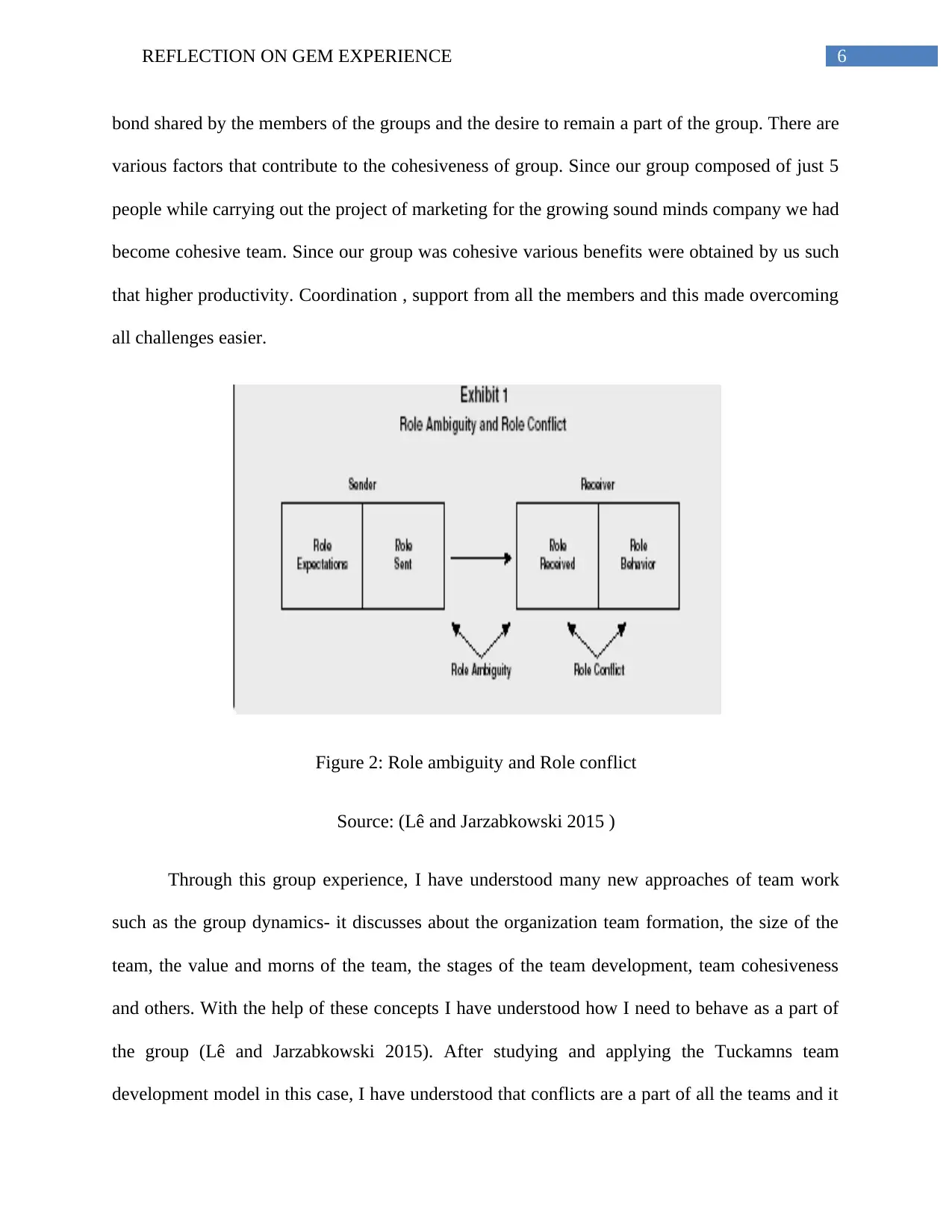
6REFLECTION ON GEM EXPERIENCE
bond shared by the members of the groups and the desire to remain a part of the group. There are
various factors that contribute to the cohesiveness of group. Since our group composed of just 5
people while carrying out the project of marketing for the growing sound minds company we had
become cohesive team. Since our group was cohesive various benefits were obtained by us such
that higher productivity. Coordination , support from all the members and this made overcoming
all challenges easier.
Figure 2: Role ambiguity and Role conflict
Source: (Lê and Jarzabkowski 2015 )
Through this group experience, I have understood many new approaches of team work
such as the group dynamics- it discusses about the organization team formation, the size of the
team, the value and morns of the team, the stages of the team development, team cohesiveness
and others. With the help of these concepts I have understood how I need to behave as a part of
the group (Lê and Jarzabkowski 2015). After studying and applying the Tuckamns team
development model in this case, I have understood that conflicts are a part of all the teams and it
bond shared by the members of the groups and the desire to remain a part of the group. There are
various factors that contribute to the cohesiveness of group. Since our group composed of just 5
people while carrying out the project of marketing for the growing sound minds company we had
become cohesive team. Since our group was cohesive various benefits were obtained by us such
that higher productivity. Coordination , support from all the members and this made overcoming
all challenges easier.
Figure 2: Role ambiguity and Role conflict
Source: (Lê and Jarzabkowski 2015 )
Through this group experience, I have understood many new approaches of team work
such as the group dynamics- it discusses about the organization team formation, the size of the
team, the value and morns of the team, the stages of the team development, team cohesiveness
and others. With the help of these concepts I have understood how I need to behave as a part of
the group (Lê and Jarzabkowski 2015). After studying and applying the Tuckamns team
development model in this case, I have understood that conflicts are a part of all the teams and it
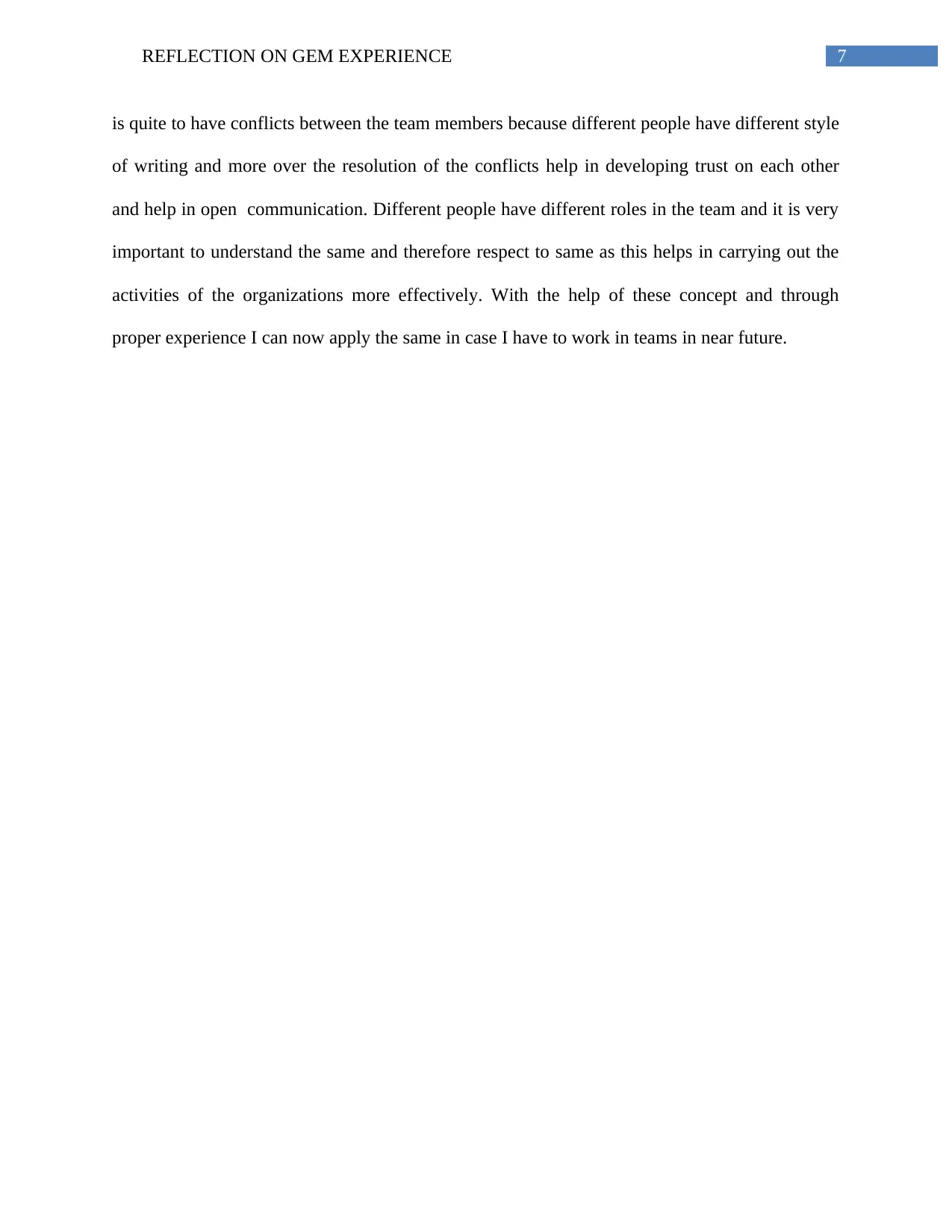
7REFLECTION ON GEM EXPERIENCE
is quite to have conflicts between the team members because different people have different style
of writing and more over the resolution of the conflicts help in developing trust on each other
and help in open communication. Different people have different roles in the team and it is very
important to understand the same and therefore respect to same as this helps in carrying out the
activities of the organizations more effectively. With the help of these concept and through
proper experience I can now apply the same in case I have to work in teams in near future.
is quite to have conflicts between the team members because different people have different style
of writing and more over the resolution of the conflicts help in developing trust on each other
and help in open communication. Different people have different roles in the team and it is very
important to understand the same and therefore respect to same as this helps in carrying out the
activities of the organizations more effectively. With the help of these concept and through
proper experience I can now apply the same in case I have to work in teams in near future.
Secure Best Marks with AI Grader
Need help grading? Try our AI Grader for instant feedback on your assignments.
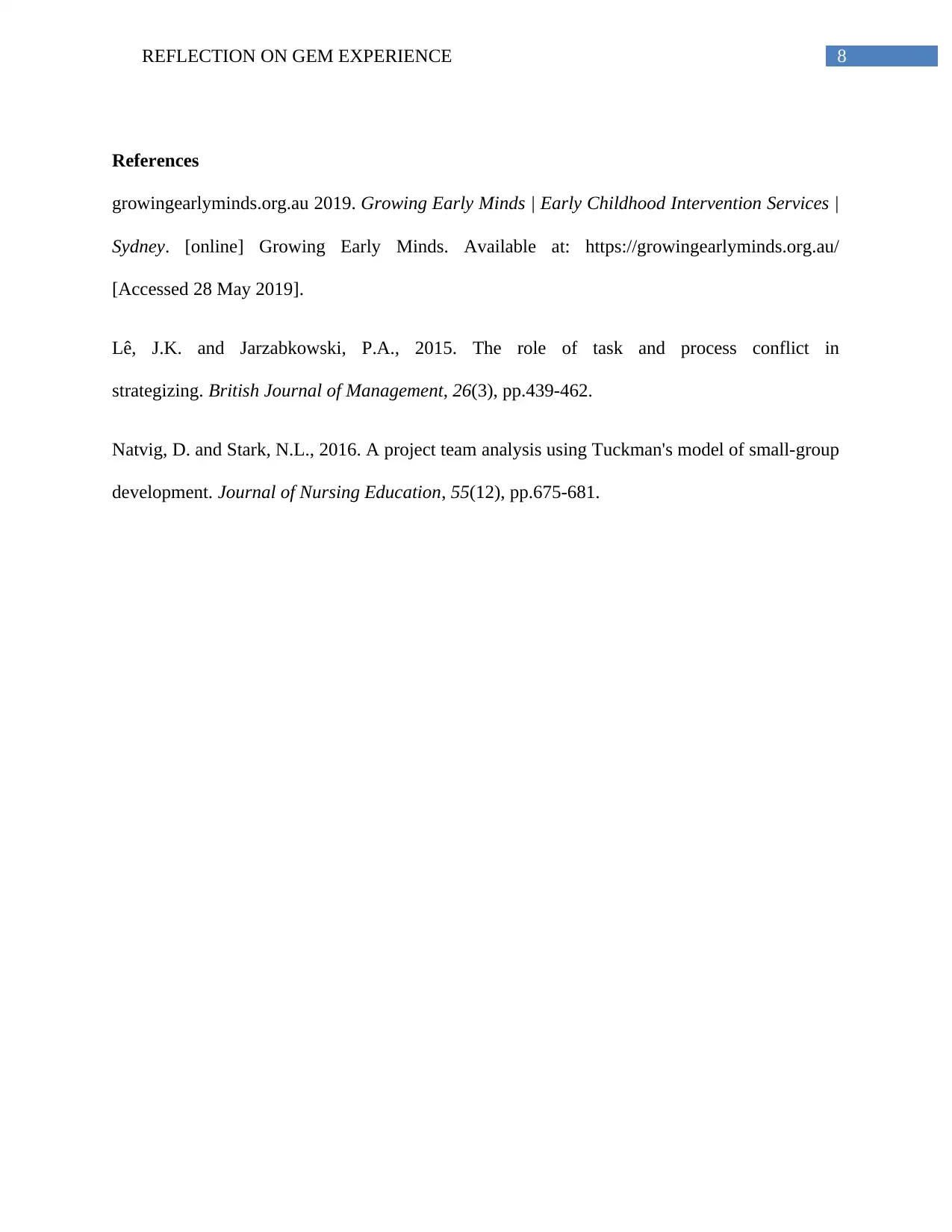
8REFLECTION ON GEM EXPERIENCE
References
growingearlyminds.org.au 2019. Growing Early Minds | Early Childhood Intervention Services |
Sydney. [online] Growing Early Minds. Available at: https://growingearlyminds.org.au/
[Accessed 28 May 2019].
Lê, J.K. and Jarzabkowski, P.A., 2015. The role of task and process conflict in
strategizing. British Journal of Management, 26(3), pp.439-462.
Natvig, D. and Stark, N.L., 2016. A project team analysis using Tuckman's model of small-group
development. Journal of Nursing Education, 55(12), pp.675-681.
References
growingearlyminds.org.au 2019. Growing Early Minds | Early Childhood Intervention Services |
Sydney. [online] Growing Early Minds. Available at: https://growingearlyminds.org.au/
[Accessed 28 May 2019].
Lê, J.K. and Jarzabkowski, P.A., 2015. The role of task and process conflict in
strategizing. British Journal of Management, 26(3), pp.439-462.
Natvig, D. and Stark, N.L., 2016. A project team analysis using Tuckman's model of small-group
development. Journal of Nursing Education, 55(12), pp.675-681.
1 out of 8
![[object Object]](/_next/static/media/star-bottom.7253800d.svg)




